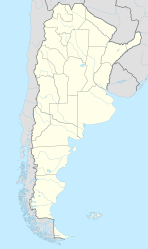San Lorenzo, Santa Fe
| San Lorenzo | |
|---|---|
| City | |
 |
|
| Location of San Lorenzo in Argentina | |
| Coordinates: 32°45′S 60°44′W / 32.750°S 60.733°WCoordinates: 32°45′S 60°44′W / 32.750°S 60.733°W | |
| Country | Argentina |
| Province | Santa Fe |
| Department | San Lorenzo |
| Government | |
| • Mayor | Leonardo Raimundo (Radical Civic Union) |
| Area | |
| • Total | 39 km2 (15 sq mi) |
| Population | |
| • Total | 159.184 hab.[1] |
| Time zone | ART (UTC-3) |
| CPA base | S2200 |
| Dialing code | +54 3476 |
San Lorenzo (Spanish pronunciation: [san loˈɾenso]) is a city in the south of the province of Santa Fe, Argentina, located 23 km north of Rosario, on the western shore of the Paraná River, and forming one end of the Greater Rosario metropolitan area. It is the head town of the San Lorenzo Department, and it has about 43,500 inhabitants according to the 2001 census [INDEC].
The area is located at the end of the Industrial Corridor of the Argentine littoral, and hosts processing industries (edible oil, flour), as well as ceramics factories and petrochemical plants. San Lorenzo's port and that of nearby Puerto General San Martín are among the largest export outlets in Argentina for primary products (soybean, wheat, maize, etc.).
San Lorenzo has no certain foundation date, but the Municipal Council decided, in 1984, to settle on 6 May 1796, the date when Franciscan friars came and started the evangelization of the area.
The city was the stage of the Battle of San Lorenzo on 3 February 1813, where troops loyal to the Spanish Crown were defeated by local revolutionaries under General José de San Martín. The 18th century San Carlos Monastery has a museum devoted to this battle, the first in the Argentine War of Independence, It is also the birthplace of Argentine footballer Javier Mascherano.
...
Wikipedia

